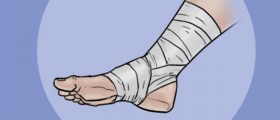
Clinical Characteristics of Tenosynovitis
Patients suffering from tenosynovitis frequently complain about difficulty moving the affected joint, joint swelling and pain and tenderness of the affected area. The pain is most intensive while moving the affected joint. The skin can be warm and red. If there is fever together with the previously mentioned symptoms and signs it is highly likely an individual has developed infection.
Therapy for TenosynovitisThe goal of the treatment for tenosynovitis is to reduce inflammation and bring all additional symptoms and signs under control. It is also important to rest the affected tendon and abstain from any unnecessary movement until it properly heals.
Immobilization of the painful area is best achieved with the assistance of a splint or a Removable brace. The doctor can also suggest application of hot and cold compresses in order to reduce swelling.
Pain, only if it is unbearable, requires proper treatment. Patients suffering from tenosynovitis are frequently prescribed NSAIDs (nonsteroidal anti-inflammatory drugs). These drugs are highly effective against both, inflammation and pain. In more serious cases patients are treated with local injections of corticosteroids. In case tenosynovitis develops due to infection treatment must include antibiotics and it may be necessary to surgically remove the pus. While recovering patients should engage in physical therapy. Such treatment helps restoring muscle function, strength and range of motion in the affected area.
Majority of patients suffering from tenosynovitis completely recover. In people who are engaged in activities or sports that cause overuse of muscles and tendons the inflammation may reoccur. This eventually leads to a chronic inflammation. Chronic tenosynovitis is a serious condition with slow or incomplete recovery.
In spite of very successful treatment options for tenosynovitis there are also potential complications. For example, if tenosynovitis develops as a consequence of infection, there is chance that the infection will spread to other parts of the body and cause serious complications. There are cases when the affected joint remains stiff although one has been treated properly. And finally, if the condition is left untreated, further progression of inflammation eventually results in tendon rupture. Such complication can be only treated surgically.

















Your thoughts on this
Loading...